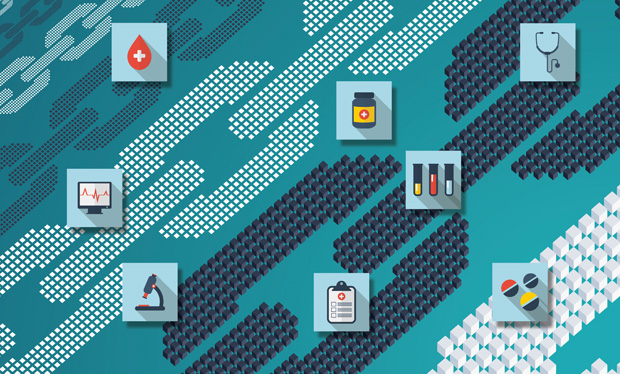Work is already underway to bring blockchain technology to the healthcare industry, and hospital administrators are trying to figure out what it can do for them, their clinicians, and their patients. That includes administrators at Beth Israel Deaconess Medical Center, a leading academic medical center located in Boston.
IEEE Pulse interviewed the medical center’s chief information officer (CIO), John D. Halamka, M.D., for his thoughts about the technology and its potential. Halamka is the International Healthcare Innovation Professor at Harvard Medical School, as well as a practicing emergency physician. He is also working with Massachusetts Institute of Technology researchers on a collaborative project to develop MedRec, a record-management system for electronic health records that uses blockchain technology.

IEEE Pulse: Many people view blockchain technology as a way to make medical records easily accessible to physicians and also allow patients to see their own records. How do you see the role of blockchain technology?
John D. Halamka: I think we have to be very careful here, because blockchain is not a panacea. I don’t know how many entrepreneurs have told me that if we just create a cloud-hosted, machine-learning-enabled blockchain, all healthcare problems would go away. And of course, that’s not true.
Where blockchain would be useful is something like this: imagine that my medical records are at the Beth Israel Deaconess Medical Center and at Marshfield Clinic in Wisconsin, but no one at Marshfield knows I have records at Beth Israel Deaconess, and no one at Beth Israel knows I have records at Marshfield. What a blockchain could do is be a ledger of where my records are.
Since a blockchain is traditionally a public ledger, it doesn’t have control over who can retrieve what, so you can imagine the problem with that when it comes to medical records. For instance, say that I have medical records at a downtown substance abuse clinic, the city’s mental health facility, and the county’s sexually transmitted disease clinic. The ledger may not tell you anything about my specific medical data, but the very fact that I have a list that includes those three facilities would be extremely disclosing.
IEEE Pulse: How might that issue be handled?
Halamka: There are probably two ways to deal with that problem. One is what MedRec is all about. MedRec doesn’t store the medical data itself in a blockchain, but it does store pointers to medical data, and it uses a “smart contract” that allows me, as the patient, to designate which people can pull the list of places I’ve been. [For more information about MedRec, see “(Block) Chain Reaction.”]
The other option, and what is potentially a more practical option, is that, even though the traditional blockchain is a public ledger, you actually have no idea about the identities of the parties who are being referred to. In other words, it doesn’t say “John Halamka,” it says something like “ABCXYZ123.” So, although you put in the blockchain every location where every patient’s records are, the patients themselves are sort of anonymous, and you’d need the patient to tell you where in the blockchain to look to find that information.
IEEE Pulse: What are some other applications for blockchain technology in health care?
Halamka: Imagine that a doctor is involved in a lawsuit and the plaintiff attorney says, “I need you to pull all the records in this case,” but when the doctor does, the attorney says, “These records have been changed.” What you can do in a blockchain is create a hash or a digest of a note (a “note” might be any type of medical data, such as test results or information about treatment history). The blockchain runs an algorithm that reduces that note to a string of numbers and letters, which are posted to the blockchain. If the note that the doctor gives to the attorney matches the blockchain hash or digest, there’s zero chance the note could have been altered. In other words, we’re not putting the note itself in the blockchain; rather, we’re posting a computational digest of the note that would show us whether the note was ever altered.
Here’s another potential application. Suppose that Pfizer produces a batch of Tylenol—maybe a million bottles—and writes into the blockchain that it introduced this lot number into the marketplace on this date. That would prevent someone else from making fake Tylenol, because you’d always be able to trace back every shipment to the fact that Pfizer created it.
One more use case for blockchain is about costs. There’s a cost—a few cents—involved in sending data back and forth between the Marshfield Clinic and Beth Israel Deaconess, so it gets a little bit overwhelming if everybody is requesting records about everything on everyone to be sent everywhere for free. Here, we could use the blockchain to create a micropayment ecosystem: one standard way to pay for record exchange.
These are just a few thoughts about applications, but you can start to see the potential.
IEEE Pulse: Where do you see blockchain technology being used first in health care?
Halamka: The Bill and Melinda Gates Foundation desires to help South Africa unify the HIV records of the country, and HIV is a huge public health problem there. The challenge is the infrastructure in South Africa is poor, power is irregular, and bandwidth is expensive, so what the Gates folks decided to do was to provide a grant to the blockchain technology company Factom of Austin, Texas, to create a highly distributed data-storage system. Basically, Factom is using a combination of regular old databases to store the data, and blockchain to ensure that data have not been changed, altered, or corrupted.
IEEE Pulse: How long do you think it will be before blockchain technology will become part of the healthcare industry?
Halamka: As with any innovation, we’ll see the early adopters for very narrow-use cases, such as the blockchain technology that is being deployed in South Africa, in 2018. I’d say we’re looking at good progress over a five-year period, but certainly this year is a good year for the early adopters to start.



